
133 Molesworth Street
PO Box 5013
Wellington 6140
New Zealand
T+64 4 496 2000
27 July 2022
Alex Parmley
Chief Executive
Waitaki District Council
[email address]
Tēnā koe Mr Parmley
Decision in relation to fluoridation direction
Thank you for responding to my letter of 3 May 2022. I have considered the information
you have provided, alongside further information I am required to consider under
section 116E of the Health Act 1956 (the Act). I have also received and considered
advice from the Director of Public Health.
Informed by the matters I am required to consider, I have decided to exercise my
statutory powers under section 116E of the Act to direct you to fluoridate the Oamaru
drinking water supply in your region.
In accordance with section 116I of the Act, you are required to ensure that by 30 June
2024 you are fluoridating at the optimal levels (between 0.7ppm to 1ppm, parts per
million) at the Oamaru supply. Contravening these requirements, or permitting these
requirements to be contravened, constitutes an offence under section 116J of the Act.
Fluoridation of the Oamaru drinking water supply is an important step in improving the
oral health of your community, and it is my intention that Manatū Hauora (the Ministry of
Health) will work constructively with you to implement these important changes.
In reaching my decision to issue this direction to you, I considered the scientific
evidence on the effectiveness of adding fluoride to drinking water in reducing the
prevalence and severity of dental decay. I am satisfied that community water
fluoridation is a safe and effective public health measure that significantly reduces the
prevalence and severity of dental decay. In reaching this conclusion, I considered:
Water fluoridation to prevent tooth decay (Cochrane Collaboration 2015),
Health effects
of water fluoridation: A review of the scientific evidence (PMCSA and Royal Society Te
Apārangi 2014) and
Fluoridation: An update on evidence (PMCSA 2021).
In reaching my decision, I also considered whether the benefits of adding fluoride to the
drinking water outweigh the financial costs, taking into account: the state or likely state
of the oral health of your community served by the Oamaru supply; the number of
people who are reasonably likely to receive drinking water from this supply; and the
likely financial cost and savings of adding fluoride to the drinking water of this supply,
including any additional financial costs of ongoing management and monitoring.
I am satisfied that the benefits of introducing community water fluoridation across the
Oamaru drinking water supply outweigh the financial costs of doing so. In reaching this
conclusion, I gave weight to the following:
• the Oamaru community would receive significant benefit, through improvement
to the state of its oral health, because fluoridation of the drinking water supply
would significantly reduce the prevalence and severity of dental decay in its
community
• approximately 15,561 people are reasonably likely to receive drinking water from
the Oamaru supply
• the likely financial cost and savings of adding fluoride to drinking water for the
Oamaru supply, including any additional financial costs of ongoing management
and monitoring.
My decision-making process included inviting written comment from Waitaki District
Council, and having regard to the comments I received. Below I summarise and
respond to the comments I received:
• the estimated capital cost of introducing fluoridation for the Oamaru supply is
$367,500. Ongoing management and monitoring costs were not specified at this
time.
• the Waitaki District Council cannot provide a date by which it could comply with a
direction, as there are many factors leading into this.
As part of considering whether to issue a direction to fluoridate, I considered the cost
estimates you provided. I have also factored in that you were unable to provide a
specific date by which you could comply with a direction. I have issued a compliance
date (30 June 2024) that I believe is reasonable given the size of the Oamaru supply
and timeframes that generally apply for supplies of this scale.
Appendix 1 presents a more extensive summary of the information that informed my
decision-making, including the advice I received and considered from the Director of
Public Health.
Funding
Manatū Hauora is making capital works funding available for local authorities that have
been issued a direction to fluoridate, and that begin work to fluoridate drinking water
supplies by the end of 2022. It will shortly provide detailed information about the
application process for this funding to cover fluoridation-related capital costs.
Communicating this ‘direction to fluoridate’ decision
Manatū Hauora is responsible for communicating this decision at a national level.
Please note too, that as required under section 116E(5) of the Act, all direction letters
will be published on the Manatū Hauora website in due course.
Page 2 of 3
 Next steps
Next steps
An official from Manatū Hauora will contact your team in the coming weeks to discuss
any needs you might have for further clarity or additional information. Manatū Hauora
recognises that this is a busy time for local authorities and wishes to work with you to
make the process as straightforward as possible for your team.
Nākū noa, nā
Dr Ashley Bloomfield
Te Tumu Whakarae mō te Hauora Director-General of Health
Page 3 of 3
Appendix 1:
Waitaki District Council: Oamaru water supply
Analysis
Criterion
1. Scientific evidence on the effectiveness of adding fluoride to drinking water in reducing the prevalence and severity of dental decay
Evidence
The Ministry has considered the following information:
•
Fluoridation: an evidence update | Office of the Prime Minister's Chief Science Advisor (June 2021)
•
Health effects of water fluoridation: A review of the scientific evidence (August 2014) Office of the Prime Ministers Chief Science
Advisor and Royal Society of New Zealand Te Aparangi
•
Water fluoridation to prevent tooth decay | Cochrane Collaboration (June 2015).
Fluoridation: An update on evidence
(PMCSA 2021) examines new evidence on water fluoridation published since the Royal Society Te
Apārangi report in 2014. The Cochrane Collaboration’s water fluoridation to prevent tooth decay (2015) is a high-quality scientific meta-
analysis of a large number of high-quality research studies conducted over a long period worldwide.
Analysis
The sources of evidence referred to above are reviews that examine substantial bodies of research generated over periods of time on the
safety of community water fluoridation (CWF) and its effectiveness at reducing dental decay. Considered together, these reports provide an
up-to-date and high-quality scientific assessment of the state of the scientific evidence on the health effects of CWF. They find that the
provision of CWF at a level of 0.7-1 mg/L is safe and significantly reduces the prevalence and severity of dental decay.
The summary analysis of evidence stated above justifies the conclusion that provision of CWF at a level of 0.7-1 mg/L in the Oamaru water
supply would be safe and effective at significantly reducing the prevalence and severity of dental decay in the populations serviced by this
water supply.
Director of
Informed by the findings of the reviews noted in ‘Criterion 1 Evidence’ above on CWF, my assessment is that there is strong evidence that
Public
CWF is a safe and effective way to improve oral health outcomes, by reducing and preventing dental decay. I also consider that this strong
Health
evidence applies to the communities served by the Oamaru water supply.
advice
Criterion
2. whether the benefits of adding fluoride to drinking water outweigh the financial costs, taking into account:
Criterion
2a. the state or likely state of the oral health of a population group or community where the local authority supply is situated
Evidence
The Ministry has considered the following information:
• data o
n Age 5 and Year 8 oral health outcomes from the Community Oral Health Service (Ministry of Health)
• data from the New Zealand Health Survey: Oral Health
(New Zealand Health Survey | Ministry of Health NZ) • Oral Health Survey Report
(Our Oral Health: Key findings of the 2009 New Zealand Oral Health Survey | Ministry of Health NZ) • 2013 New Zealand Index of Deprivation (NZD
ep) (Socioeconomic deprivation profile | ehinz)
This is the most relevant up-to-date data available. It should be noted that oral health outcome data can take a long time to change
substantially.
Analysis
The Oamaru supply is situated within the previous Southern District Health Board area.
2020 data for children aged 0-12 in Southern District Health Board show:
-
overall, 32 percent of children had experienced tooth decay at age five
-
on average, children at age five have 1.29 decayed, missing or filled primary teeth, and at school year 8 have on average 0.66
decayed, missing or filled adult teeth
-
Māori and Pacific children have significantly worse outcomes than other children within Southern District Health Board. For
example, 46 percent of Māori children had experienced decay at age five compared to 28 percent for all other (non-Māori and non-
Pacific) children.
The 2017- 2020 New Zealand Health Survey results for Southern District Health Board show:
-
47.6 percent of adults (15+) had one or more teeth removed in their lifetime due to decay, an abscess, infection or gum disease
-
7.1 percent of adults (15+) had one or more teeth removed in the last 12 months due to decay, an abscess, infection or gum disease.
From the data summarised above, it is reasonable to conclude that there are significant levels of dental decay in the communities serviced
by the Oamaru water supply. There is strong evidence that CWF reduces dental decay. There are therefore also significant opportunities for
oral health improvement for the communities served by the Oamaru water supply. The evidence indicates that fluoridation of the Oamaru
water supply would make significant improvements to oral health outcomes for the communities it serves.
Within the Oamaru area, there are significant levels of deprivation. In the 10-level score in which decile 1 has the least deprivation, Oamaru
South is in decile 6, and Oamaru Central and Oamaru North are in decile 7. There is a significant body of evidence that levels of tooth decay
are highest among the most deprived socioeconomic groups.
Director of
Informed by the evidence and data sources listed above at ‘Criterion 1 Evidence’ and ‘Criterion 2a Evidence’, I have reviewed the state of
Public
oral health of the populations served by the Oamaru supply. In summary, my assessment is as follows. The Oamaru population presently
Health
have significant levels of preventable dental decay. The evidence that CWF improves oral health outcomes by reducing dental decay is
advice
applicable to this population. So too is the evidence that these benefits tend to be greater for populations that experience higher levels of
tooth decay, such as Māori and Pacific communities. Fluoridation of the water supply that serve these communities would consequently
improve oral health outcomes and is likely also to reduce health inequities.
Criterion
2b. the number of people who are reasonably likely to receive drinking water from the local authority supply
Evidence
We have considered the following information:
•
the Public Register of Drinking Water Suppliers.
Analysis
Water supply
Population size
Oamaru
15,561
Criterion
2c. the likely financial cost and savings of adding fluoride to the drinking water, including any additional financial costs of ongoing
management and monitoring
Evidence
The Ministry has considered the following information:
•
Review of the Benefits and Costs of Water Fluoridation in New Zealand. Sapere Research Group. May 2015.
•
Water Fluoridation Engineering Costs. August 2015. • Waitaki District Council’s estimated costs, including ongoing management and monitoring costs (for more detail on Waitaki District
Council’s comments see table below).
Analysis
The 2015 Sapere Report estimated that adding fluoride to New Zealand’s water treatment plants classified as medium sized and above (ie,
those supplying populations of over 5000) is cost-saving, and for smaller supplies (ie, those supplying populations of over 500) is likely to be
cost-saving. The Sapere report also noted:
-
an estimated total net discounted saving over 20 years for smaller supplies and above to be $1,401 million, made up of a cost of
fluoridation of $177 million and cost offsets of $1,578 million from reduced dental decay
-
“We estimate the 20-year discounted net saving of water fluoridation to be $334 per person, made up of $42 for the cost of
fluoridation and $376 savings in reduced dental care”
The Oamaru supply fits into the category of supplies servicing over 5000 people (see further detail in Criterion 2b).
The estimated costs provided by Waitaki Council are presented in the table below. These estimates vary from the cost estimates Sapere
2015 used in reaching its conclusion that fluoridation is cost-saving for supplies servicing over 5000 people. For water supplies servicing over
10,000 people, Sapere 2015 estimated $347,004 for capital costs, and $8742 per annum for management and monitoring costs; while for
the Oamaru supply servicing 15,561 people, Waitaki District Council estimated $367,500 for capital costs. The ongoing management and
monitoring costs for the Oamaru supply were not specified.
Water Supply
Population size
Waitaki District Council
Waitaki District Council
estimate of capital cost
estimate of management and
monitoring costs (per annum)
Oamaru
15,561
$367,500
n/a
Total
15,561
$367,500
Summary of the information received from Waitaki District Council
As required by section 116G, Waitaki District Council was invited to give written comments on the estimated financial costs of adding fluoride to the
drinking water, including any additional costs of ongoing management and monitoring; and the date by which each local authority would be able to comply
with a direction. Waitaki District Council responded within the required timeframe. A copy of Waitaki District Council’s formal response is attached to this
Report as Appendix One.
For Waitaki District Council’s estimated financial costs of adding fluoride to the drinking water, including any additional costs of ongoing management and
monitoring please see Criterion 2c above.
Oamaru Water Supply
The Waitaki District Council cannot provide a date by which it could comply with a direction, as there are many factors leading into this.
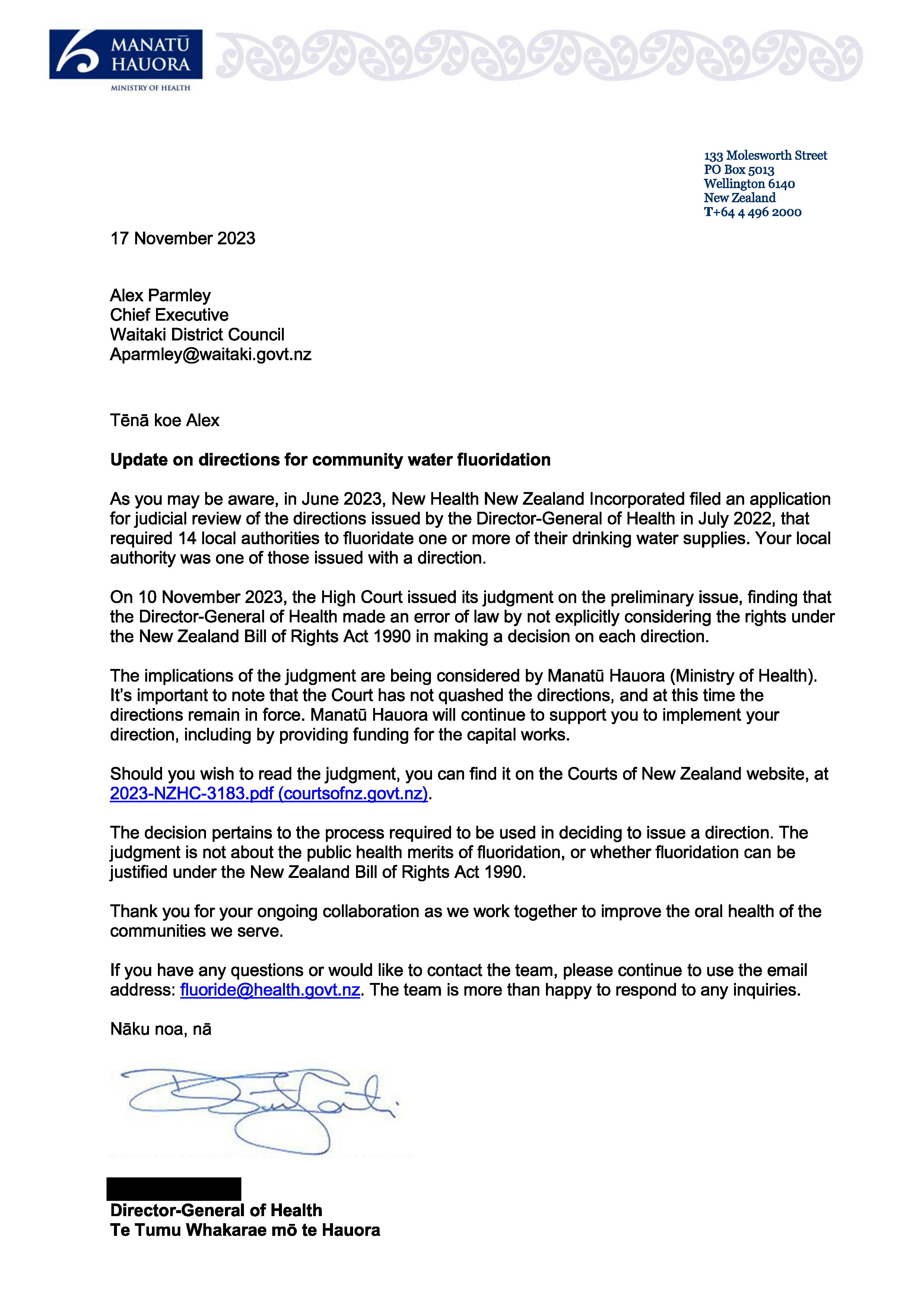



133 Molesworth Street
PO Box 5013
Wellington 6140
New Zealand
T+64 4 496 2000
22 February 2024
Alex Parmley
Chief Executive
Waitaki District Council
[email address]
Tēnā koe Alex
Community water fluoridation court decision update
I am contacting you to provide an update on the judicial review of the directions issued by the
Director-General of Health in July 2022, that required 14 local authorities to fluoridate one or
more of their drinking water supplies.
As you are aware, on 10 November 2023, the High Court issued its judgment on the preliminary
issue, finding that the Director-General of Health made an error of law by not explicitly
considering the rights under the New Zealand Bill of Rights Act 1990 in making a decision on
each direction. There was a second hearing on 2 February 2024 to consider the validity of the
current directions, and any relief.
The Judge decided that the directions remain in place. However, the Judge directed the
Director-General of Health to assess whether each of the 14 directions made in 2022 were, in
terms of section 5 of the New Zealand Bill of Rights Act, a justified limit on the right to refuse
medical treatment that is provided for in section 11 of the New Zealand Bill of Rights Act.
As directed by the Judge, I will carry out this assessment against the New Zealand Bill of Rights
Act, for each of the directions. I will continue to update you as this process progresses.
Manatū Hauora is continuing to provide support to local authorities that are implementing their
directions, including by providing funding for the capital works.
Thank you for your ongoing collaboration as we work together to improve the oral health of the
communities we serve.
Nāku noa, nā
Dr Diana Sarfati
Director-General of Health Te Tumu Whakarae mō te Hauora
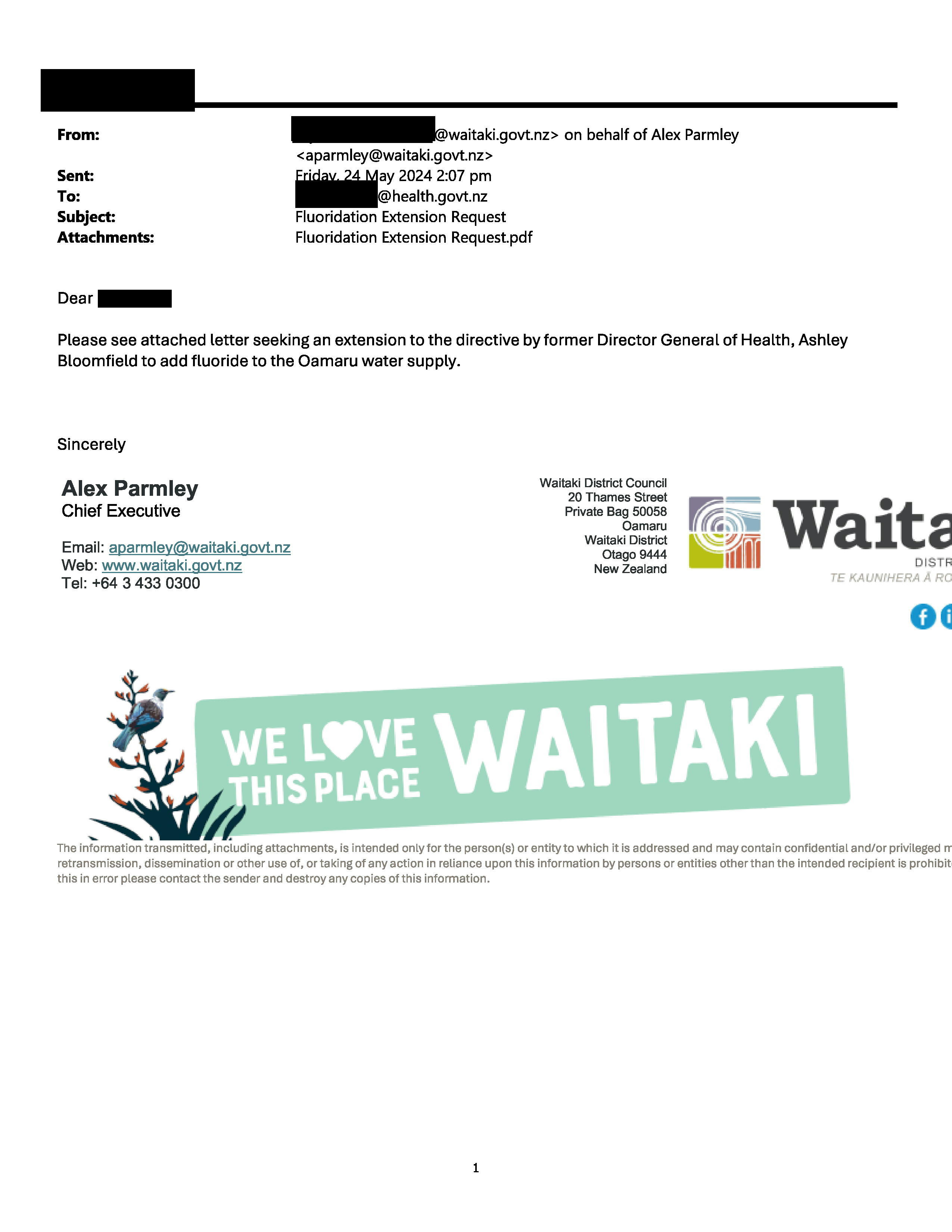



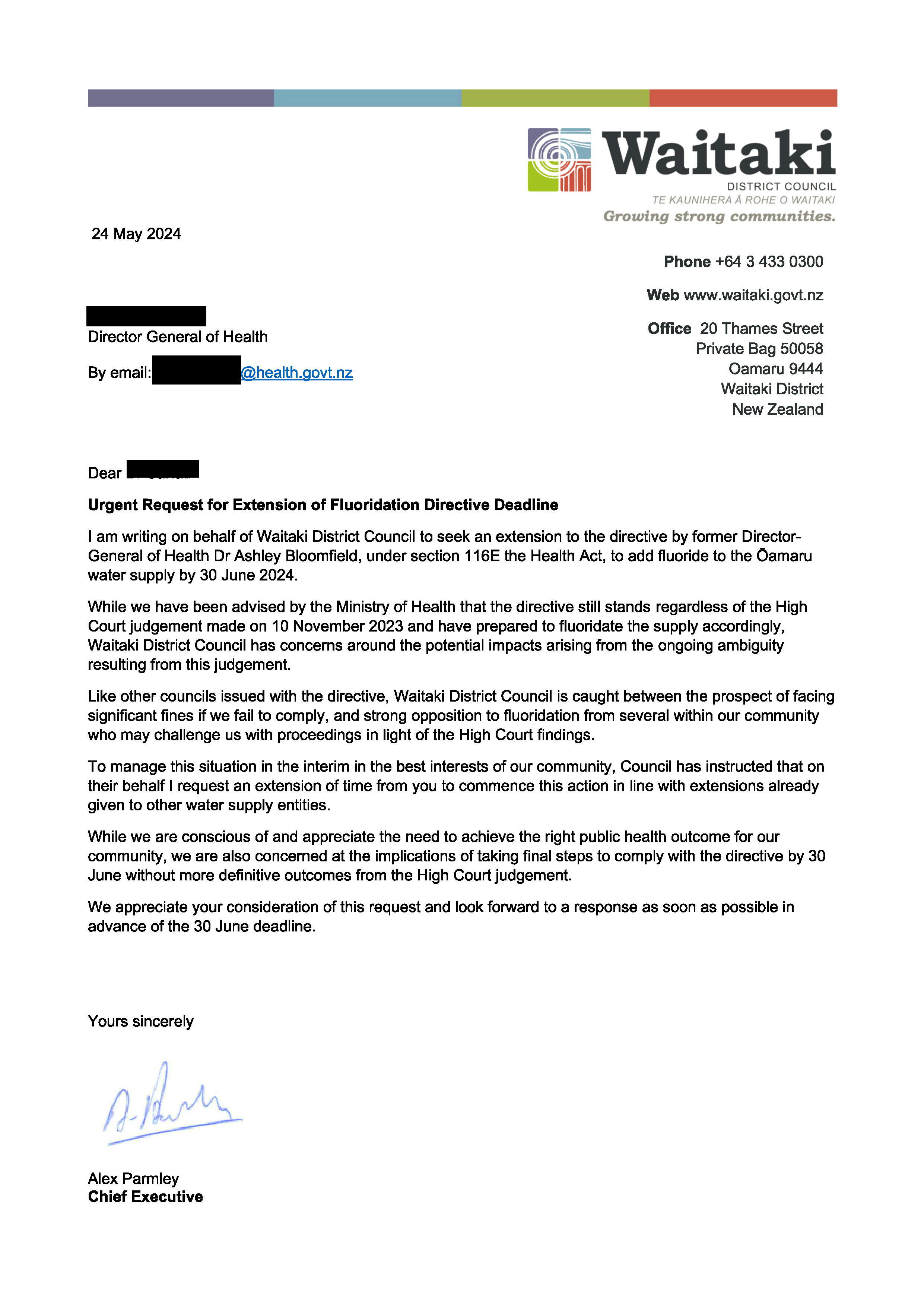

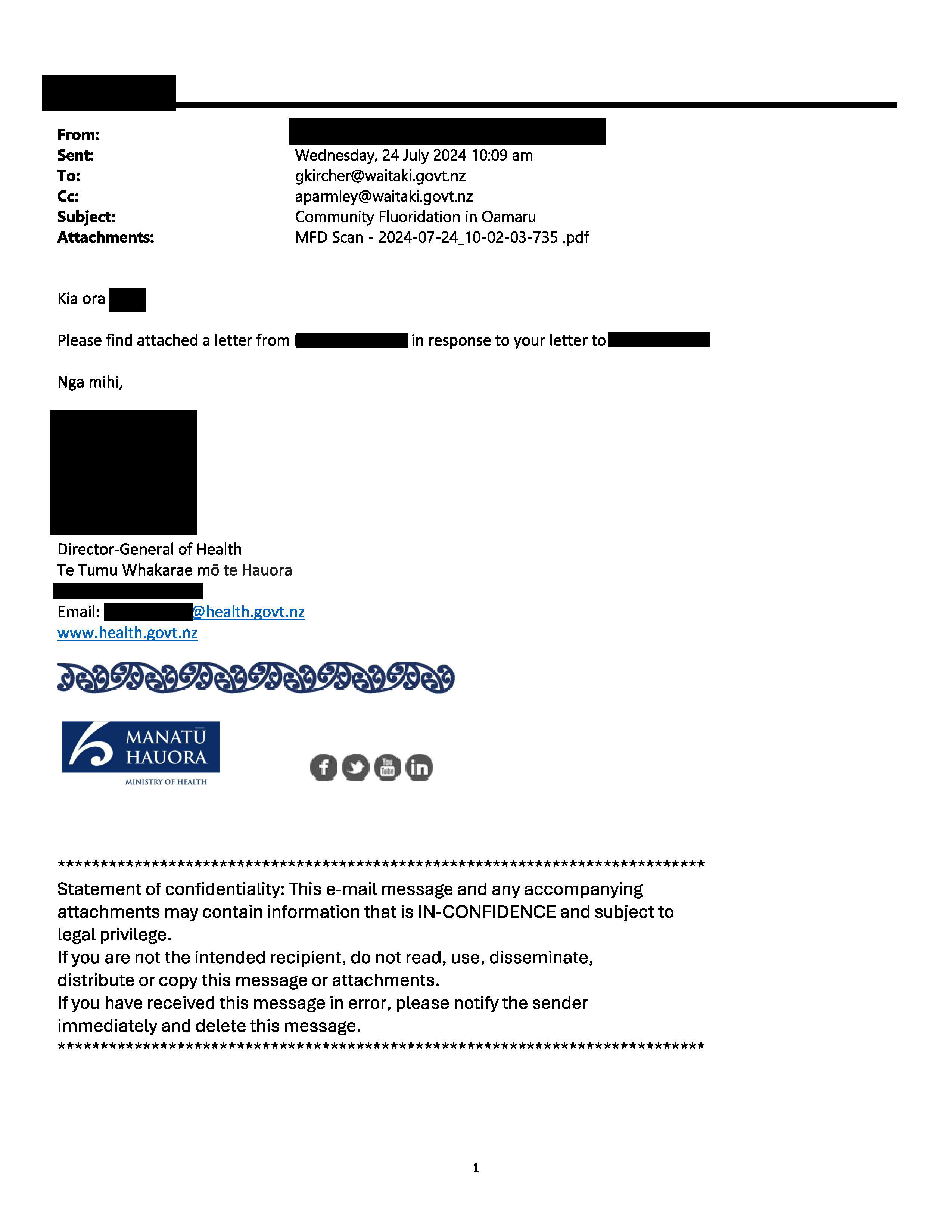



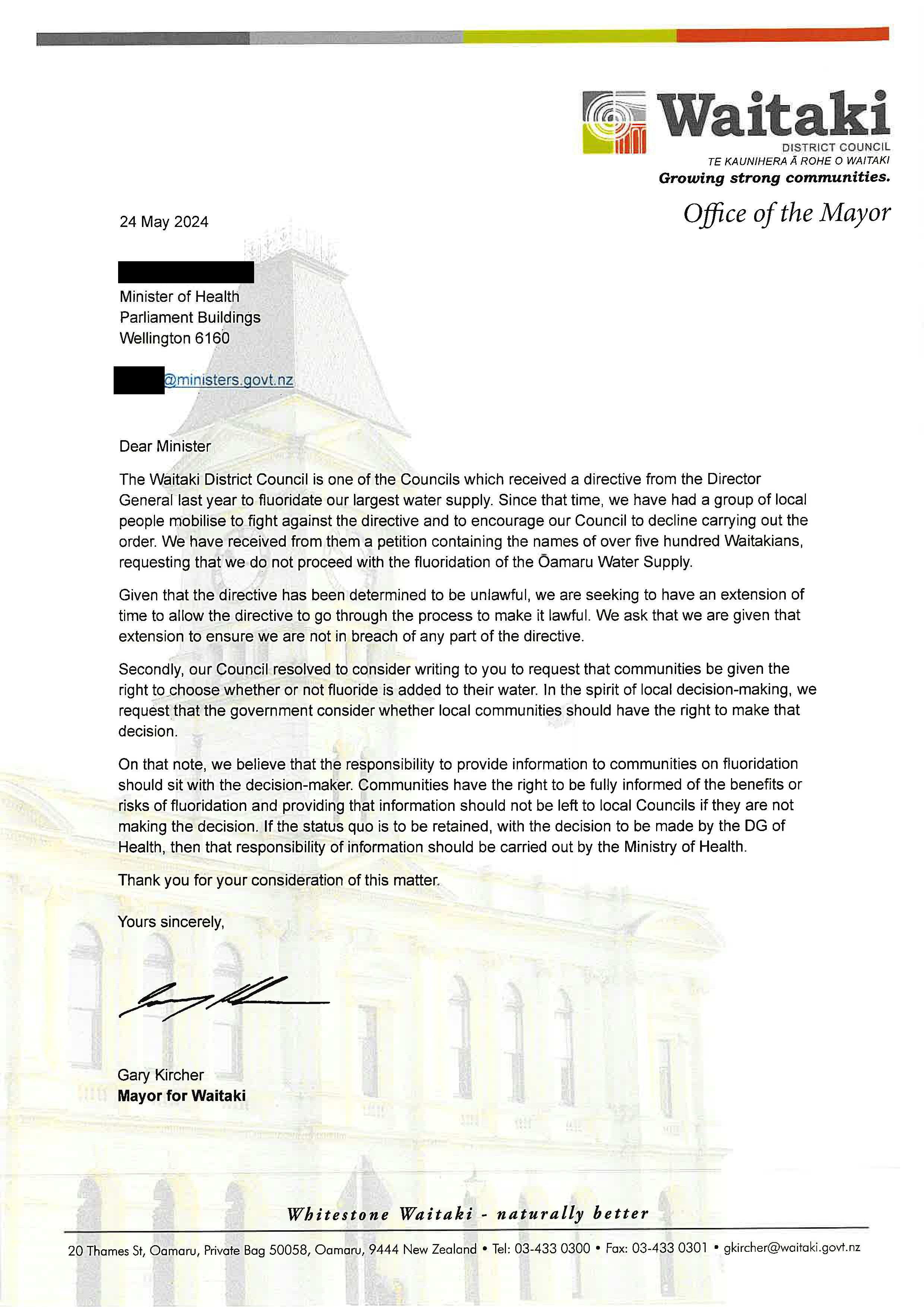
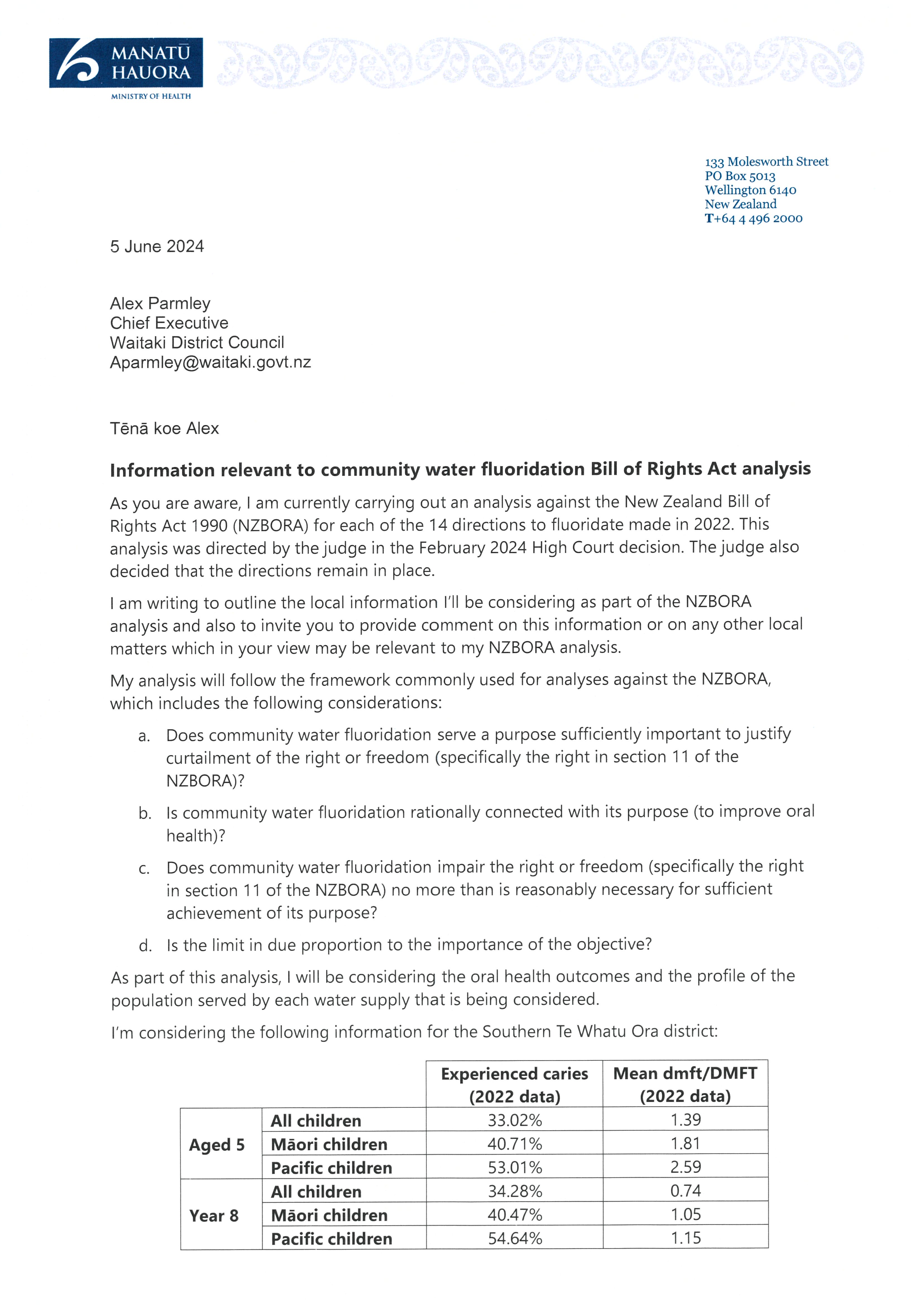

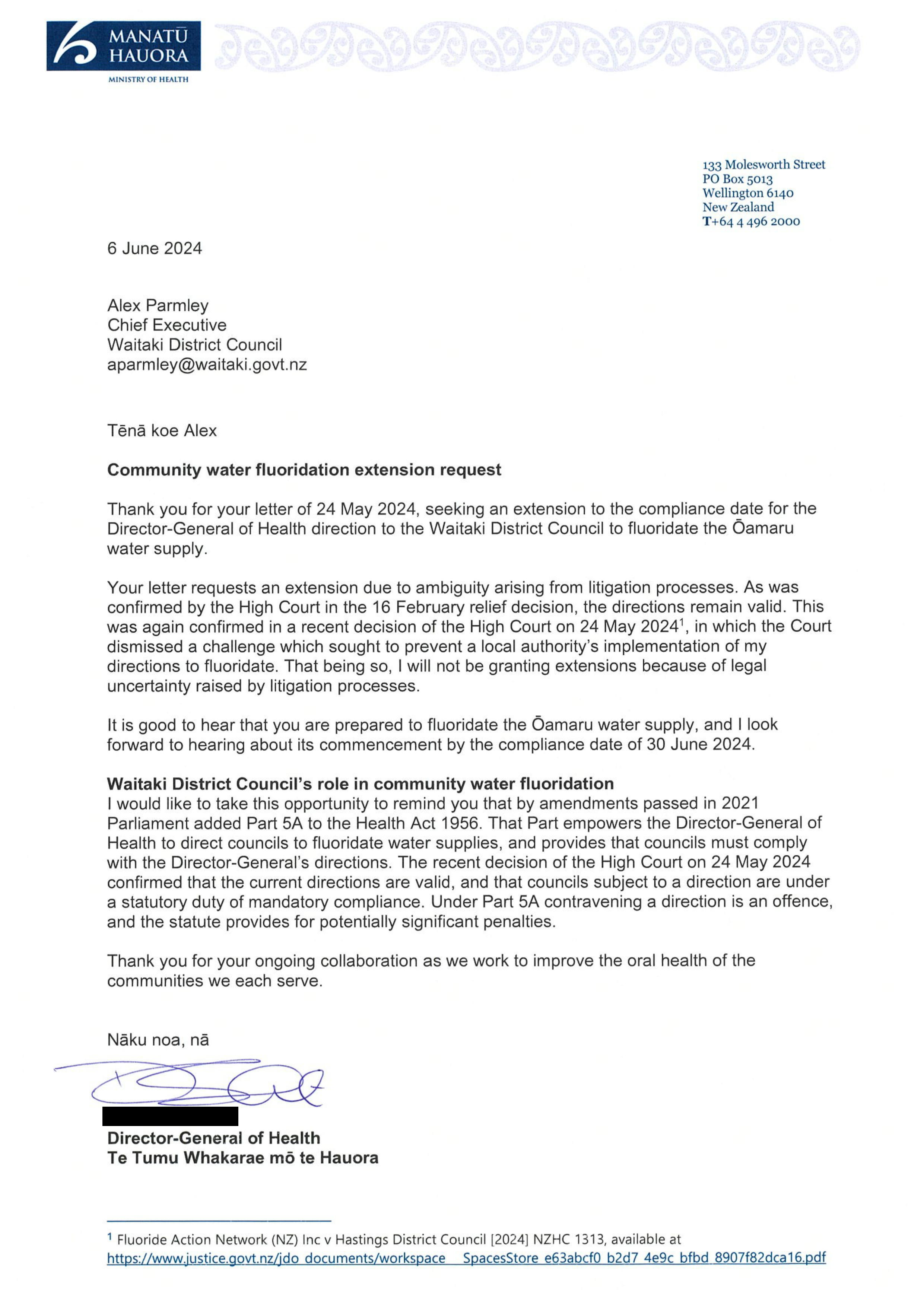

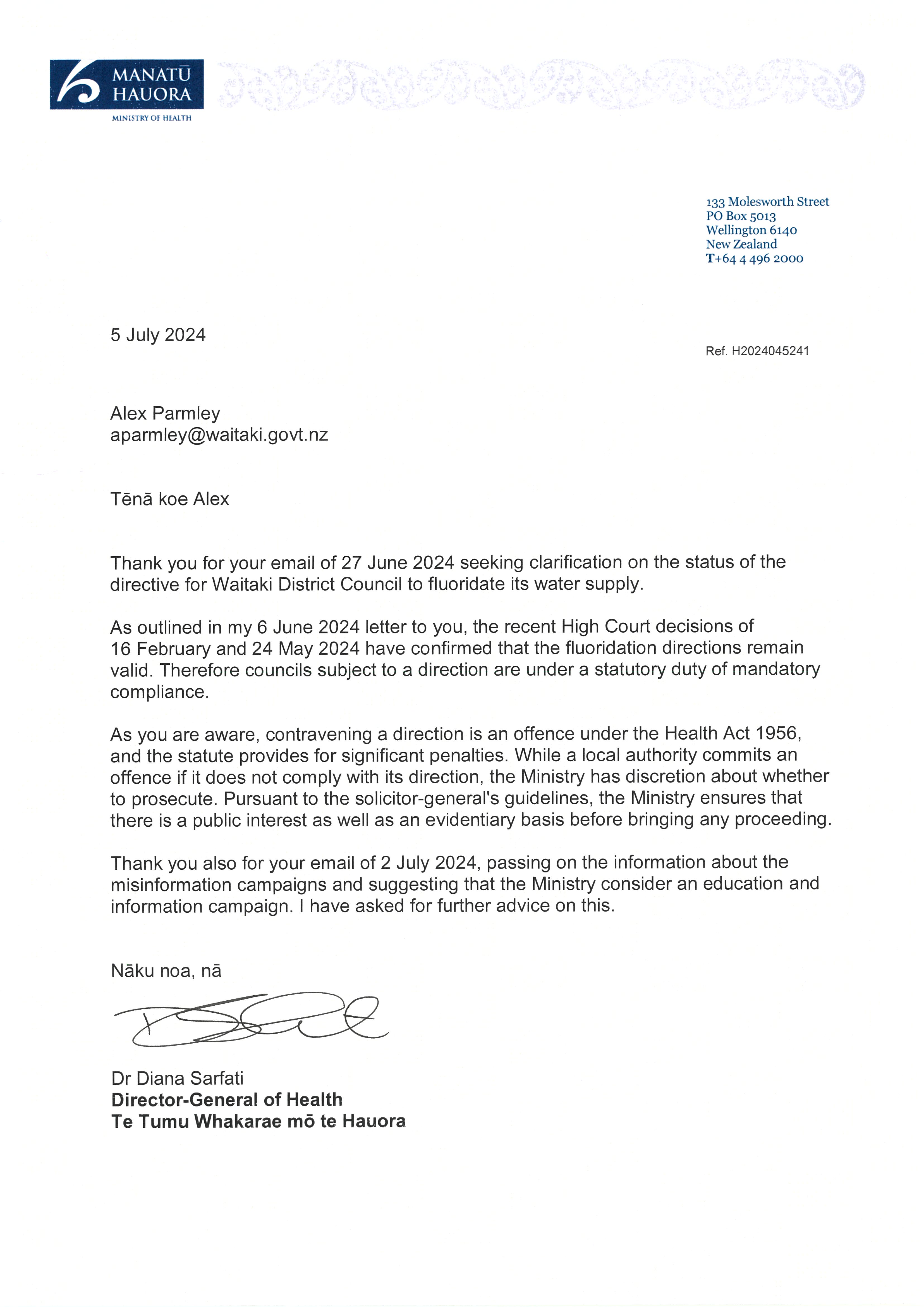

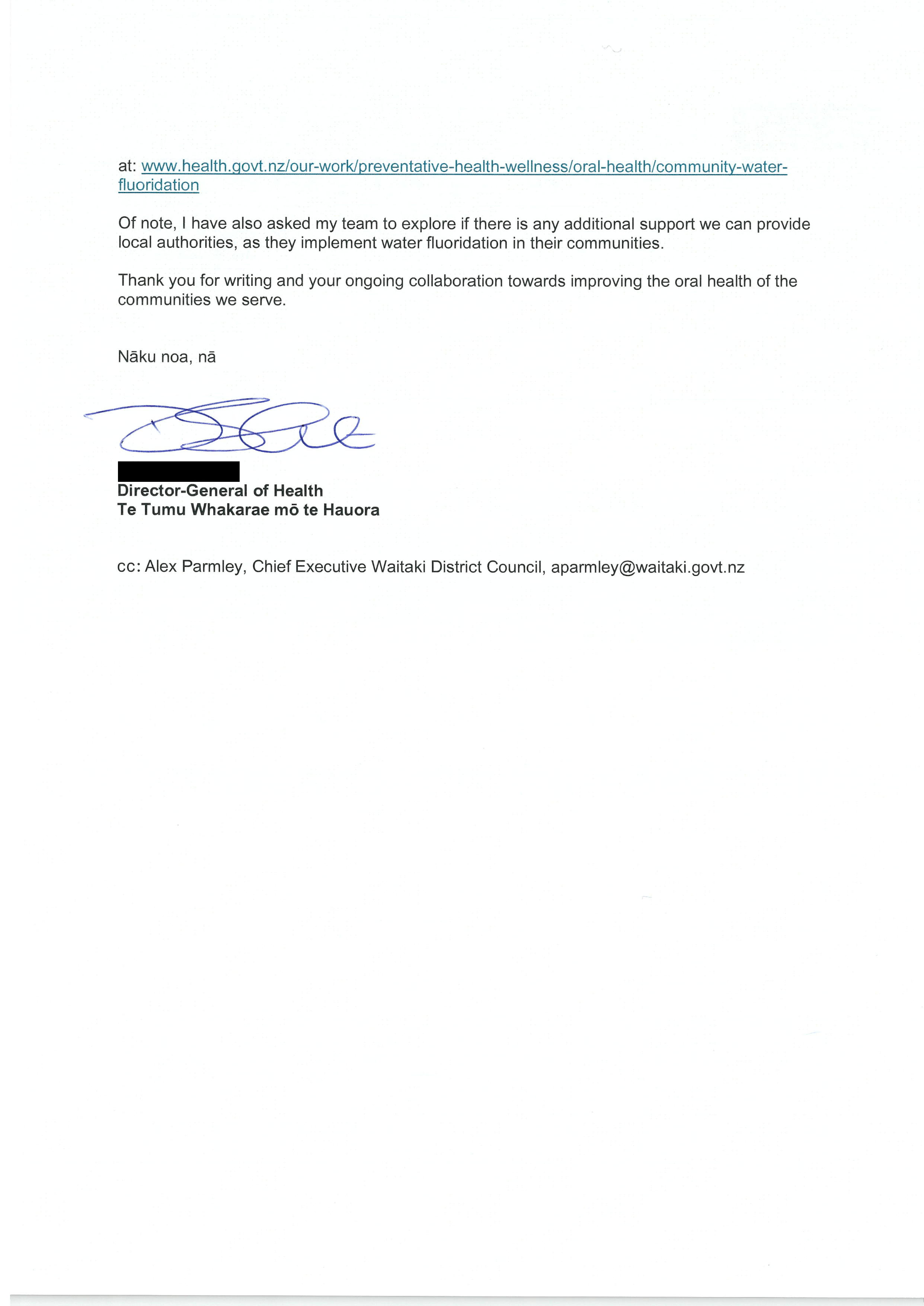
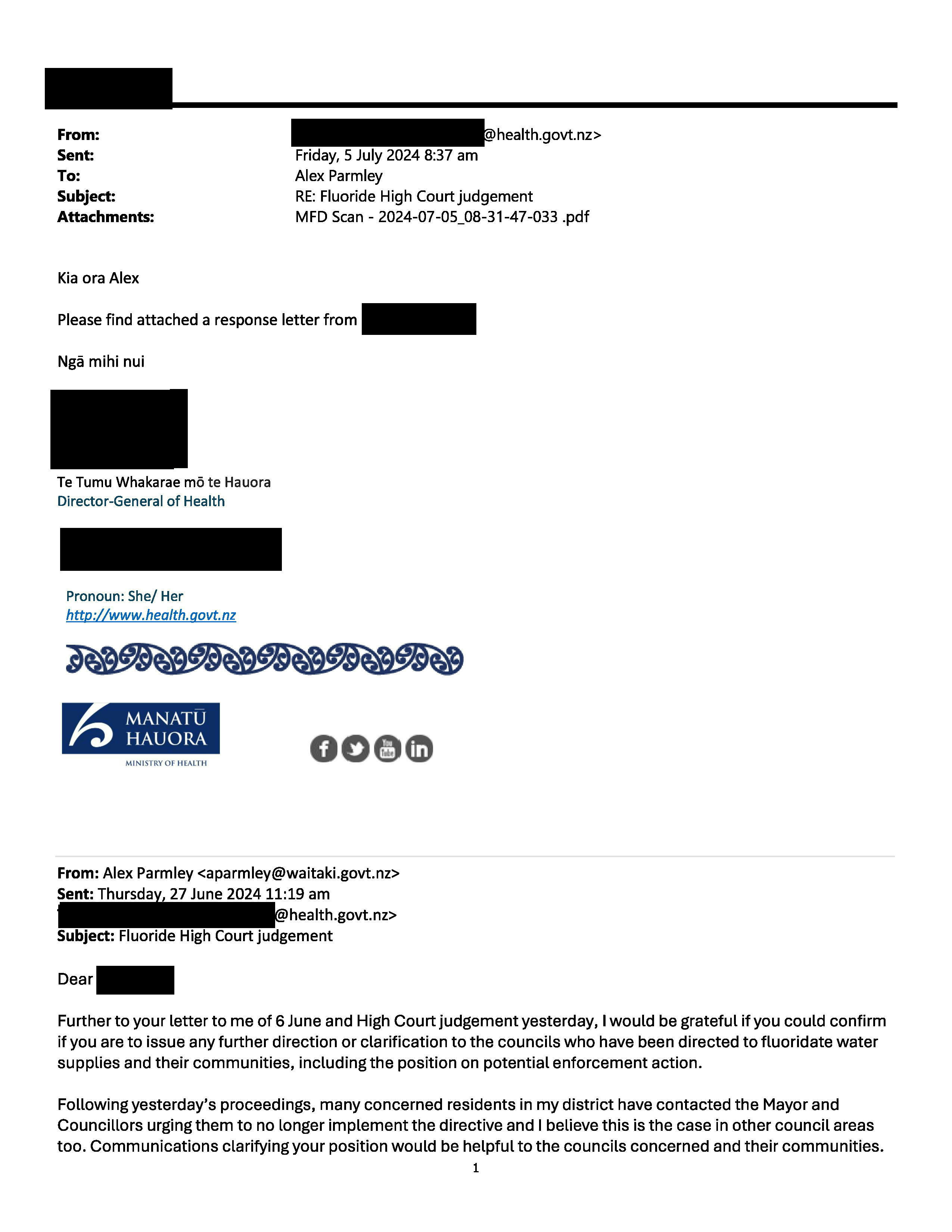










Given the imminent deadline and the level of community concern, I would appreciate if you were able to give this
your urgent attention.
Ngā mihi nui
Alex
Alex Parmley
Waitaki District Council
20 Thames Street
Chief Executive
Private Bag 50058
Oamaru
Waitaki District
.Email: [email address]
Otago 9444
Web: www.waitaki.govt.nz
New Zealand
Tel: +64 3 433 0300
The information transmitted, including attachments, is intended only for the person(s) or entity to which it is addressed and may contain confidential and/or privileged material. Any review,
retransmission, dissemination or other use of, or taking of any action in reliance upon this information by persons or entities other than the intended recipient is prohibited. If you receiv
this in error please contact the sender and destroy any copies of this information.
Disclaimer
The information contained in this communication from the sender is confidential. It is intended solely for
use by the recipient and others authorized to receive it. If you are not the recipient, you are hereby
notified that any disclosure, copying, distribution or taking action in relation of the contents of this
information is strictly prohibited and may be unlawful.
This email has been scanned for viruses and malware, and may have been automatically archived by
Mimecast Ltd, an innovator in Software as a Service (SaaS) for business. Providing a safer and more
useful place for your human generated data. Specializing in; Security, archiving and compliance. To find
out more Click Here.
****************************************************************************
Statement of confidentiality: This e-mail message and any accompanying
attachments may contain information that is IN-CONFIDENCE and subject to
legal privilege.
2
If you are not the intended recipient, do not read, use, disseminate,
distribute or copy this message or attachments.
If you have received this message in error, please notify the sender
immediately and delete this message.
****************************************************************************
3
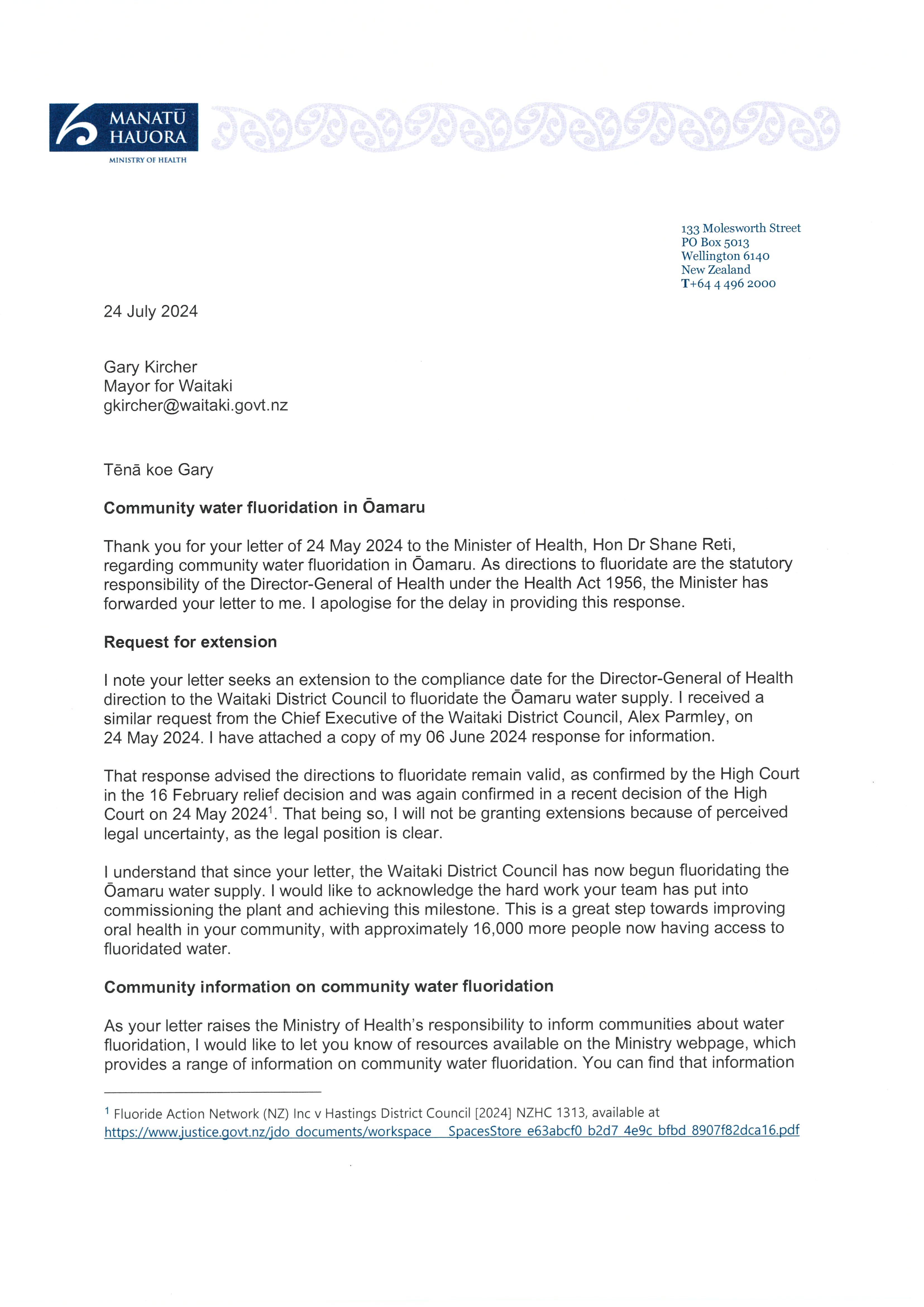
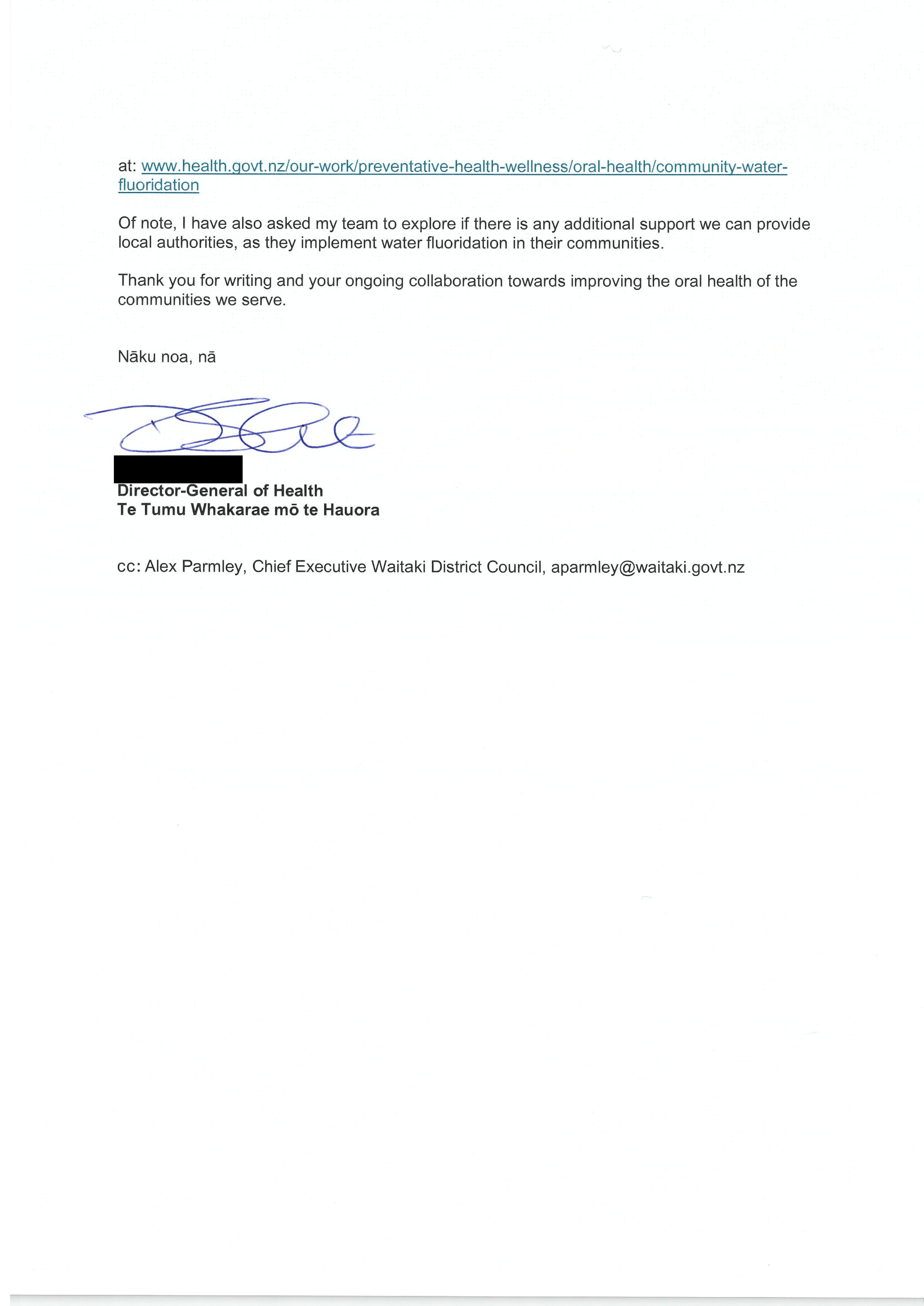


133 Molesworth Street
PO Box 5013
Wellington 6140
New Zealand
T+64 4 496 2000
4 September 2023
Alex Parmley
Chief Executive
Waitaki District Council
[email address]
Tēnā koe Alex
Update on consideration of directions for community water fluoridation
Thank you for working constructively with Manatū Hauora as you work to implement
fluoridation in the Oamaru drinking water supply.
I last wrote to you on 3 November 2022 letting you know that I was actively
considering 27 local authorities for a potential direction to fluoridate, under section
116E of the Health Act 1956, and that your local authority was not one of those being
considered. Today I am writing to provide an update on this process.
The decision to issue directions to the 27 local authorities mentioned above remains
under active consideration. This is due to taking further time to consider the impact
of several wider factors including the Government’s Water Services Reform
programme, capacity pressures across the water services sector, and the impact of
the recent weather events in the North Island. I have also written to the 27 local
authorities under active consideration regarding this process.
Local authorities that received Director-General of Health directions to fluoridate in
July 2022 are making good progress. One supply is now being fluoridated, and more
are expected over the next 12 months. Manatū Hauora is working closely with these
local authorities, and I appreciate the ongoing engagement as they work to
implement community water fluoridation. Importantly, Manatū Hauora is gaining
insights from this work that I will also be taking into consideration when making
further decisions about directions to fluoridate.
At this stage, no further action is required from your Council. I will write to you again
when I am able to provide any further updates relating to the timing of my decision-
making. I will also be in touch with you should I decide to consider your local
authority for a direction to fluoridate. At that time, I will seek written comment from
you on the estimated costs of fluoridation, and the date by which you could comply
with a direction to fluoridate.

In the meantime, there is nothing to prevent you from fluoridating your water supplies
in the absence of a direction from me, should you decide to do so. Community water
fluoridation is an effective way to improve oral health outcomes for your
communities.
Thank you for your collaboration as we work together to improve the oral health of
the communities we serve.
If you have any questions or would like to contact the team, please continue to use
the email address: [email address]. The team would be more than happy to
respond to any inquiries.
Nāku noa, nā
Dr Diana Sarfati
Director-General of Health Te Tumu Whakarae mō te Hauora
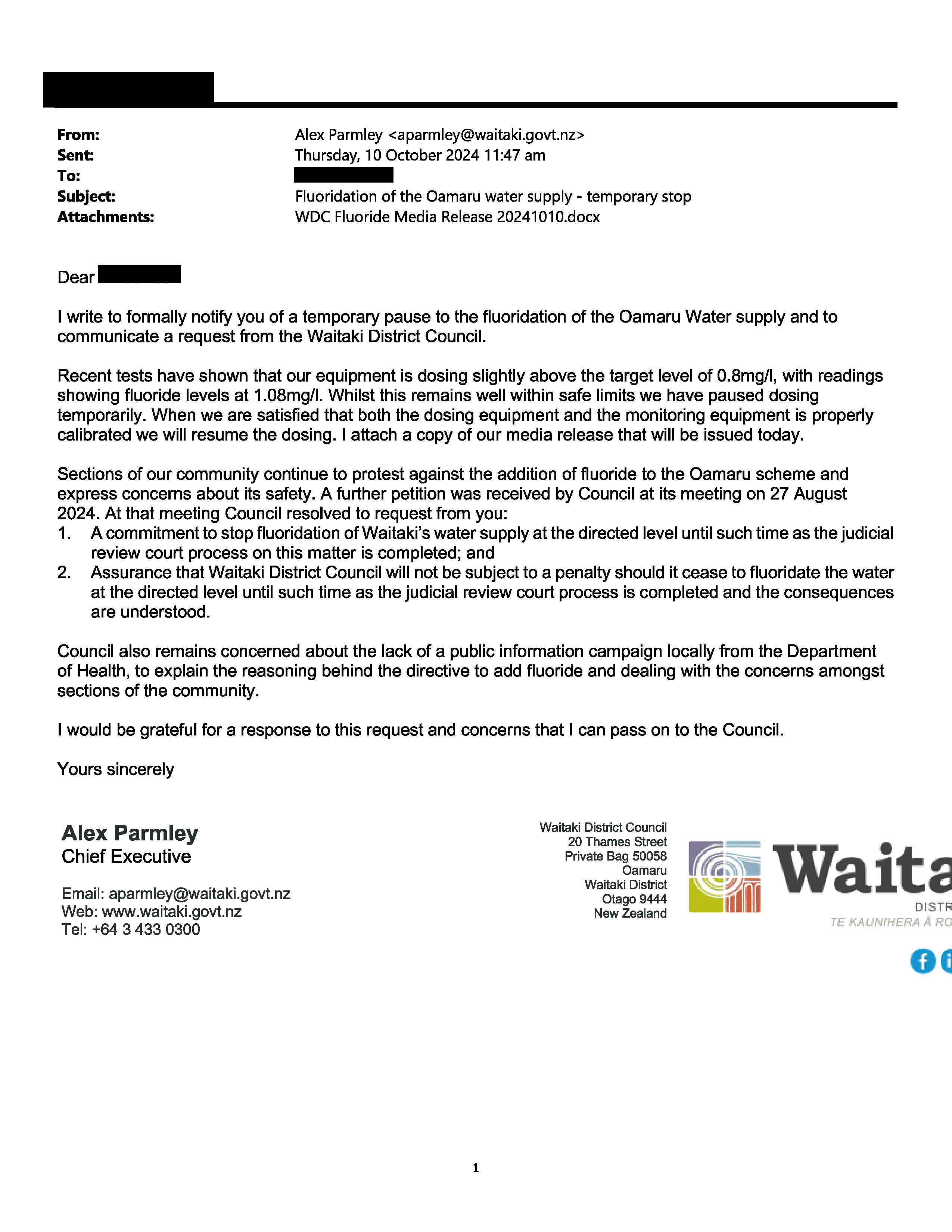



The information transmitted, including attachments, is intended only for the person(s) or entity to which it is addressed and may contain confidential and/or privileged material. Any review,
retransmission, dissemination or other use of, or taking of any action in reliance upon this information by persons or entities other than the intended recipient is prohibited. If you receiv
this in error please contact the sender and destroy any copies of this information.
2

Thursday 10th October 2024
Temporary Fluoridation pause on Oamaru Supply
Waitaki District Council is temporarily pausing the fluoridation of the Oamaru
Water Supply.
Council targets 0.8 mg/L for fluoridation, following the Director General of Health’s
directive to fluoridate between 0.7 and 1.0 mg/L. Testing this week indicated levels
of 1.07mg/L post-reservoir, and 1.08mg/L at South Hill.
Whilst marginally above the target level, these levels remain well within the
Maximum Acceptable Value for fluoride in safe drinking water set at 1.5mg/L in
the Water Services (Drinking Water Standards for New Zealand) Regulations 2022.
Fluoridation has stopped while Council’s Water Services and our commissioning
contractors Filtec recalibrate our dosing equipment and analyser to ensure water
is fluoridated at around 0.8mg/L.
Water from the Oamaru Supply will continue to have fluoride present for up to
two weeks from today as our reservoirs and wider network contains already
fluoridated water.
It is anticipated that recalibration will be complete within two weeks, and
fluoridation can recommence.
When fluoridation restarts, Council will perform regular testing at the treatment
plant and in the reticulation network with an accredited laboratory, in addition to
continue to use the dosing and analyser recording to ensure it remains at the
targeted 0.8mg/L which is the requirement for monitoring fluoridated supplies.
The Director General of Health has been notified that dosing has stopped to allow
for this recalibration.
ENDS












































